Azalea varieties encompass diverse flowering shrubs, each with unique characteristics, colors, and forms. These botanical treasures belong to the Rhododendron genus, captivating gardeners and nature enthusiasts worldwide.
With an array of species and cultivars, each with its unique charm, azalea varieties present a delightful palette of colors, shapes, and scents. As part of the Rhododendron genus, these botanical treasures have won the hearts of gardening enthusiasts and nature lovers.
From the elegant Royal Azalea, hailing from East Asia to the resilient Swamp Azalea that thrives in wetlands, each variety boasts a tale of adaptation, loveliness, and botanical fascination.
We’ll discover popular azalea types’ qualities, origins, and unique attributes. This voyage explores the wonderful world of azaleas and their natural environments, from the flaming Flame Azalea to the early-blooming Pink-Shell Azalea. Explore the magical world of azalea variety with us.
Different Azalea Varieties
There are more than 8,000 officially recognized varieties of azaleas. It means there is a plant habit, size, color, and bloom season for every landscape design scheme or individual taste.
This list, however, will break down the major categories for you. A wide variety of azaleas is shown here, including both native and hybrid varieties, as well as evergreen and deciduous forms.
1: Cumberland Azaleas
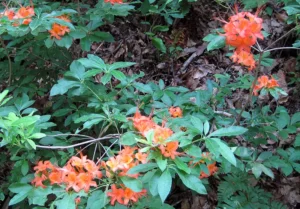
Source Pinterest
- Hardiness Zone: 5-8
- Mature Height: 3-7
- Mature Spread: 3-6
Cumberland Azaleas often get mistaken for their fiery cousins, the Flame Azaleas. Let’s shed light on the differences that set them apart:
Both boast orange blossoms, but Cumberland Azaleas exhibit some unique traits. Their blossoms tend to be smaller, and they bloom later than Flame Azaleas. Furthermore, their color palette offers fewer varieties compared to Flame Azaleas.
The origins of the Cumberland Azalea trace back to the Cumberland area of Kentucky, giving it its name. However, it thrives in various states, from Georgia to North Carolina. Regardless of its state of residence, this Azalea thrives in windy, rocky peaks and slopes.
With a moderate size, Cumberland Azalea is an excellent choice for focal point plantings in residential areas. If provided with the right conditions, shade, and moist soil, this shrub can infuse your landscape with a vibrant orange splash during summer.
2: Sweet Azalea
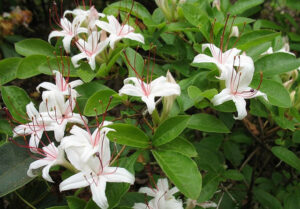
Source Pinterest
- Hardiness Zone: 4-7
- Mature Height: 8-20’
- Mature Spread: 8-20’
Sweet Azalea, scientifically known as Rhododendron arborescens, is a native beauty that thrives across the eastern United States, from the serene banks of rushing streams to lofty mountain peaks, notably gracing the Appalachian Mountains.
Its remarkable cold-hardiness sets this shrub apart, making it an ideal choice for azalea enthusiasts in colder regions. The name “Sweet Azalea” is aptly derived from the enchanting fragrance of its mostly white blooms, which persist from mid-spring into late summer.
While their colors may not be the most vivid, Sweet Azaleas display an undeniably elegant two-tone design, with most flowers in white. Still, a striking exception is the vivid crimson “pistol.”
This shrub boasts a low, spreading profile, thrives in moist environments, and, in autumn, treats onlookers with brilliant shades of crimson before its leaves gently fall to the ground. Given its impressive stature, Sweet Azalea is known by alternate names such as Tree Azalea and Smooth Azalea, making it a captivating addition to any landscape.
3: Coast Azalea

Source Pinterest
- Hardiness Zone: 6-8
- Mature Height: 2-6’
- Mature Spread: 2-5’
The Coast Azalea is a visual treat with its two-toned aromatic blossoms, mostly white with hints of pink. But it’s not just the blossoms that impress; the greenish-blue leaves provide a striking contrast.
While it can reach a height of about 5 ft, Coast Azaleas often stay smaller. They spread through suckering and thrive in brighter light than other azaleas. The key to their success is keeping their roots wet to avoid leaf scorching from sun exposure.
To help the plant retain moisture, consider mulching around it. You can expect a healthy Coast Azalea with vibrant mid-spring coloration in your yard with proper care.
4: Flame Azalea

Source Pinterest
- Hardiness Zone: 5-7
- Mature Height: 4-8’
- Mature Spread: 8-10’
The Flame Azalea is a native beauty found in the southern and central United States, serving as the ancestor of various azalea hybrids. Here’s what you should know:
Flame Azalea’s unique features include its vibrant funnel-shaped blooms, which, though lacking fragrance, dazzle in shades of yellow, orange, and crimson when fully open. During the fall, this azalea surprises with its short, bright yellow leaves, adding color to the landscape.
Remember that Flame Azaleas have preferences. They don’t like hot temperatures and spread more than grow. Despite their southern origin, they thrive in zones no hotter than zone 7 and should not have their roots immersed.
To ensure your Flame Azalea flourishes, consider providing a raised bed with nutrient-rich soil, and aim for partial shade when planting to replicate its natural woodland habitat.
5: Pink-Shell Azalea

Source Pinterest
- Hardiness Zone: 5-7
- Mature Height: 10-15’
- Mature Spread: 8-10’
The Pink-Shell Azalea stands out with its unique traits, particularly in azaleas. Its early blooming, starting in April, well before its leaves emerge, truly sets it apart, adorning its branches with a splendid flush of pale pink.
But it’s not just the timing; the Pink-Shell Azalea’s flowers are distinctive, lacking the typical tube found in most azaleas, with its petals barely touching, creating an unusual appearance.
This trait is an unmistakable flag, allowing for quick and simple differentiation between it and its azalea kin. It is an alluring and easily distinguishable addition to gardens and landscapes and provides a pleasant early spring show.
6: Swamp Azalea

Source Pinterest
- Hardiness Zone: 4-9
- Mature Height: 3-5’
- Mature Spread: 3-5’
The Swamp Azalea is a versatile shrub with a vast natural range, covering most of the eastern United States, from Maine to Florida. This circular shrub displays remarkable resilience, as it can tolerate occasional flooding, thriving in low-lying areas with stagnant water.
A significant advantage of this feature is the shrub’s reduced susceptibility to root rot, setting it apart from other azalea varieties. Swamp Azaleas adorn the landscape with tubular, fragrant, and white blossoms.
While they bloom slightly later than most native azaleas in May, their flowers linger into midsummer, providing an extended period of floral beauty. During the growing season, the leaves boast a glossy, deep green hue, transitioning into a captivating array of autumn colors, including vibrant shades of orange and purple.
7: Royal Azalea
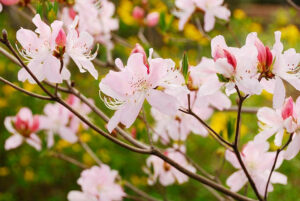
Source Pinterest
- Hardiness Zone: 4-7
- Mature Height: 4-6’
- Mature Spread: 3-5’
The Royal Azalea is a compact, fragrant flowering shrub native to East Asia, featuring large white and pink blossoms and vibrant autumn foliage. Its versatility shines as it’s hardy in zones 4-7, accommodating cold and mild climates.
This compact shrub reaches a modest 3-foot height with a rounded shape. In spring, fragrant white and pink blossoms exceeding 3 inches in diameter complement the appearance of its large leaves, ranging from 2 to 5 inches. As autumn arrives, these leaves undergo a striking transformation, turning from yellow to vivid crimson.
The species name commemorates Russian Alexander von Schlippenback, who brought the plant to Europe, Latinizing his surname. The Royal Azalea brings elegance to different environments with fragrant flowers, dramatic leaf changes, and Old World exploration.
8: Sunset Pink Azalea
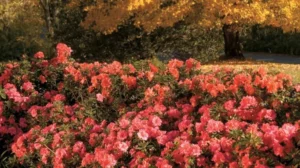
Source Pinterest
- Hardiness Zone: 7-9
- Mature Height: 2-4
- Mature Spread: 2-4
This sturdy, ever-blooming species provides gorgeous pink bouquets with an orange “blotch” on each blossom. The mounding form and bright green leaves are ideal for a border plant for hedges or perennial gardens or as a magnificent foundation plant for flower beds.
Despite their common name, all hybrid azaleas are members of the Rhododendron family. Azaleas and cherry blossoms symbolize spring in the traditional Japanese garden. Gardens, hedges, and foundations get springtime color from these plants.
9: Gumpo Pink Azalea

Source Pinterest
- Hardiness Zone: 7-9
- Mature Height: 1–2
- Mature Spread: 2-3
This little perennial shrub shows a spectacular show of light pink flowers in late autumn. Lean limbs are draped with verdant foliage. It’s a win-win for nature.
The Pink Gumpo Azalea, or Satsuki, produces enormous, lacey pink blossoms. This dwarf Azalea is perfect for small gardens and pots.
Despite its small size, this Azalea makes for a lovely carpet. Pink Gumpo Azalea is evergreen and requires little maintenance.
As the name implies, this is a smaller-scale model. The full-grown Pink Gumpo azalea typically stands 1-2 feet tall and spreads 2–4 feet wide. Adding Gumpo azaleas to nooks, flower beds, and containers considerably enhances their aesthetic value.
10: Blaauw’s Pink Azalea
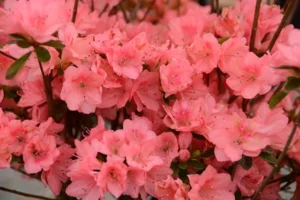
Source Pinterest
- Hardiness Zone: 6-8
- Mature Height: 3-6
- Mature Spread: 4-6
Blaauw’s Pink Azalea is a vibrant flowering shrub known for its stunning pink blossoms. It typically reaches 3 to 6 feet and thrives in hardiness zones 6-8.
This perennial has delicate pink blooms with a darker pink scar, making it a fantastic choice for creating a stunning focal point in the garden when planted in a group.
Even before the leaves fully expand by late spring, the Blaauw’s Pink Azalea is covered with delicately pink trumpet-shaped flowers. The tree’s branches and trunks are covered with shiny evergreen leaves. The thin leaves don’t change to vibrant hues as the season continues.
The deciduous Blaauw’s bush is rather thick and spreads out vertically. Compared to attractive bushes with smoother leaf textures, this one stands out.

